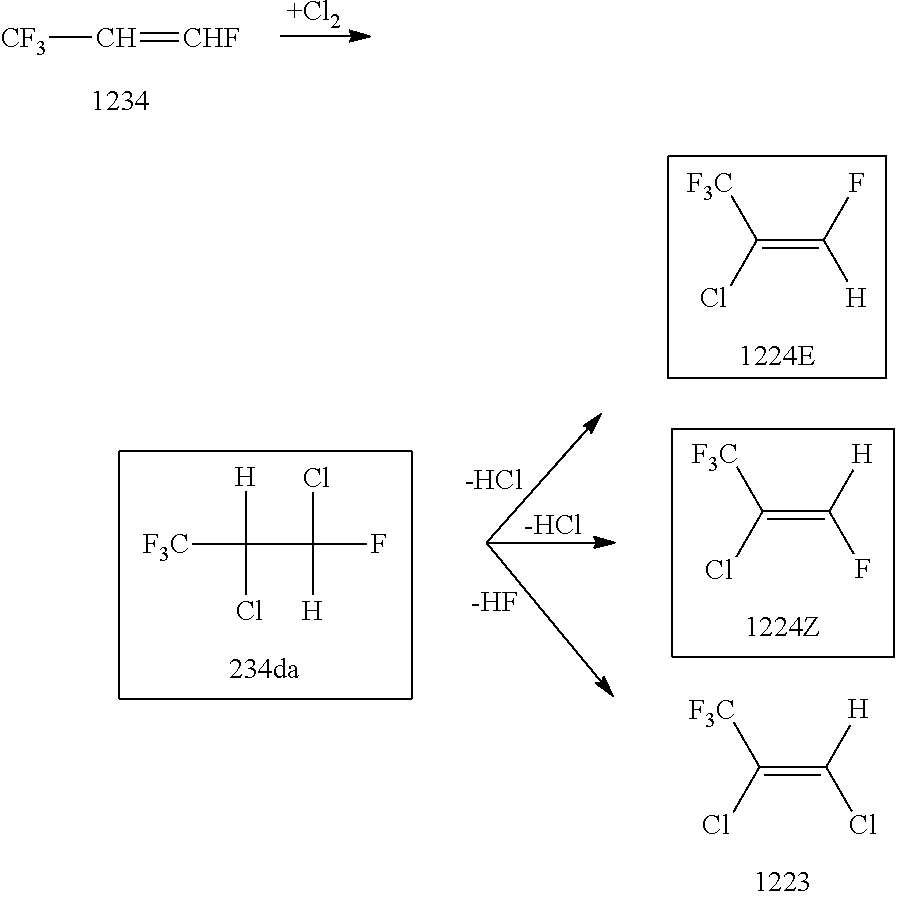Method for Producing 2-Chloro-1,3,3,3-Tetrafluoropropene
a technology of tetrafluoropropene and tetrafluoropropene, which is applied in the field of production methods for producing 2chloro1, 3, 3, 3tetrafluoropropene, can solve the problems of inefficiency in obtaining, and achieve the effect of suppressing generation and efficient production
- Summary
- Abstract
- Description
- Claims
- Application Information
AI Technical Summary
Benefits of technology
Problems solved by technology
Method used
Image
Examples
examples
[0053]The present invention will be described in more detail below by way of the following examples. It should be understood that the following examples are illustrative and are not intended to limit the present invention thereto. In the following examples, the compositions of organic substances were measured with a gas chromatograph (GC) using a hydrogen flame ionization detector (FID) and indicated by area% of the resulting GC record as “GC %” unless otherwise specified.
preparation example
Preparation of 2,3-dichloro-1,1,1,3-tetrafluoropropane (234da)
[0054]Provided was a 2000-ml glass reactor with a gas introduction hole. The bottom of the reactor was immersed and cooled in a dry ice / acetone bath of −78° C. Next, 901.86 g (7.90 mol) of trans-1,3,3,3-tetrafluoropropene as a starting material was placed into the reactor. The reaction was initiated by blowing chlorine (Cl2) into the reactor at 1.70 g / min while keeping the reactor immersed in the acetone bath. The starting material and chlorine inside the reactor were stirred by a magnetic stirrer under the condition that the reactor was externally irradiated with ultraviolet light from a high-pressure mercury-vapor lamp. After the stirring for 5 hours and 30 minutes, the reaction was completed. The total introduction amount of the chlorine was 560.5 g (7.90 mol). The content of the reactor was washed with water, washed with a saturated aqueous solution of sodium hydrogencarbonate and then washed with a saturated solution...
example 1
[0055]Into a 1-L four-neck flask with a Dimroth condenser, a 500-ml dropping funnel, a thermometer and a magnetic stirrer, 2.00 g (0.006 mol) of tetrabutylammonium bromide (TABA) as a phase transfer catalyst, 555.14 g (3.00 mol) of 234da prepared in Preparation Example were placed. The bottom of the flask was immersed in an ice water bath of 0 to 5° C. Stirring of the content of the flask was started while refluxing the content of the flask with flow of a coolant of −15° C. through the Dimroth condenser. Then, 504.47 g (3.15 mol) of a 25 mass % aqueous solution of sodium hydroxide (NaOH, pKa=15 or greater) was gradually dropped into the flask through the dropping funnel over 132 minutes. The content of the flask was stirred for 1 hour at the same temperature as above. After that, the flask was cooled in an ice water bath until the inside temperature of the flask became 5° C. or lower. The Dimroth condenser and the dropping funnel was detached from the flask. Instead, a simple distil...
PUM
| Property | Measurement | Unit |
|---|---|---|
| pKa | aaaaa | aaaaa |
| pKa | aaaaa | aaaaa |
| temperature | aaaaa | aaaaa |
Abstract
Description
Claims
Application Information
 Login to View More
Login to View More - R&D
- Intellectual Property
- Life Sciences
- Materials
- Tech Scout
- Unparalleled Data Quality
- Higher Quality Content
- 60% Fewer Hallucinations
Browse by: Latest US Patents, China's latest patents, Technical Efficacy Thesaurus, Application Domain, Technology Topic, Popular Technical Reports.
© 2025 PatSnap. All rights reserved.Legal|Privacy policy|Modern Slavery Act Transparency Statement|Sitemap|About US| Contact US: help@patsnap.com

